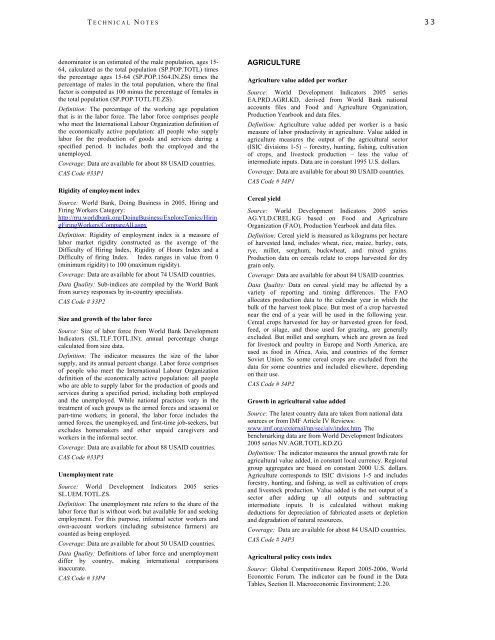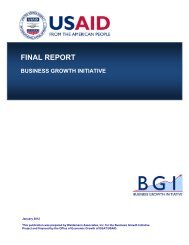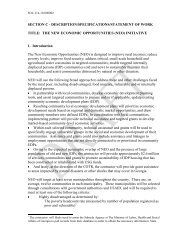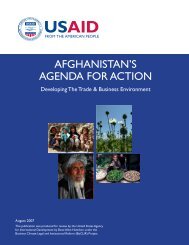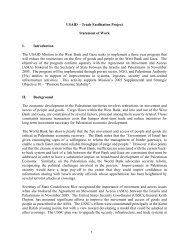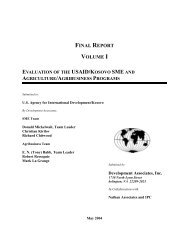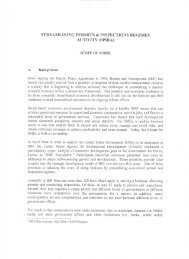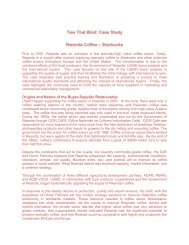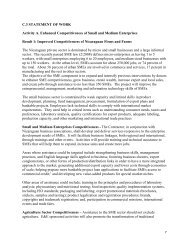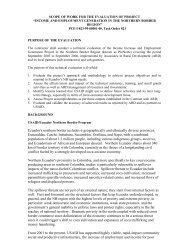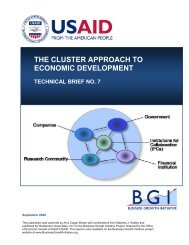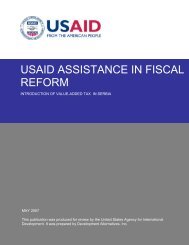El Salvador Economic Performance Assessment - Economic Growth ...
El Salvador Economic Performance Assessment - Economic Growth ...
El Salvador Economic Performance Assessment - Economic Growth ...
Create successful ePaper yourself
Turn your PDF publications into a flip-book with our unique Google optimized e-Paper software.
T ECHNICAL N OTES33denominator is an estimated of the male population, ages 15-64, calculated as the total population (SP.POP.TOTL) timesthe percentage ages 15-64 (SP.POP.1564.IN.ZS) times thepercentage of males in the total population, where the finalfactor is computed as 100 minus the percentage of females inthe total population (SP.POP.TOTL.FE.ZS).Definition: The percentage of the working age populationthat is in the labor force. The labor force comprises peoplewho meet the International Labour Organization definition ofthe economically active population: all people who supplylabor for the production of goods and services during aspecified period. It includes both the employed and theunemployed.Coverage: Data are available for about 88 USAID countries.CAS Code #33P1Rigidity of employment indexSource: World Bank, Doing Business in 2005, Hiring andFiring Workers Category:http://rru.worldbank.org/DoingBusiness/ExploreTopics/HiringFiringWorkers/CompareAll.aspxDefinition: Rigidity of employment index is a measure oflabor market rigidity constructed as the average of theDifficulty of Hiring Index, Rigidity of Hours Index and aDifficulty of firing Index. Index ranges in value from 0(minimum rigidity) to 100 (maximum rigidity).Coverage: Data are available for about 74 USAID countries.Data Quality: Sub-indices are compiled by the World Bankfrom survey responses by in-country specialists.CAS Code # 33P2Size and growth of the labor forceSource: Size of labor force from World Bank DevelopmentIndicators (SL.TLF.TOTL.IN); annual percentage changecalculated from size data.Definition: The indicator measures the size of the laborsupply, and its annual percent change. Labor force comprisesof people who meet the International Labour Organizationdefinition of the economically active population: all peoplewho are able to supply labor for the production of goods andservices during a specified period, including both employedand the unemployed. While national practices vary in thetreatment of such groups as the armed forces and seasonal orpart-time workers; in general, the labor force includes thearmed forces, the unemployed, and first-time job-seekers, butexcludes homemakers and other unpaid caregivers andworkers in the informal sector.Coverage: Data are available for about 88 USAID countries.CAS Code #33P3Unemployment rateSource: World Development Indicators 2005 seriesSL.UEM.TOTL.ZS.Definition: The unemployment rate refers to the share of thelabor force that is without work but available for and seekingemployment. For this purpose, informal sector workers andown-account workers (including subsistence farmers) arecounted as being employed.Coverage: Data are available for about 50 USAID countries.Data Quality: Definitions of labor force and unemploymentdiffer by country, making international comparisonsinaccurate.CAS Code # 33P4AGRICULTUREAgriculture value added per workerSource: World Development Indicators 2005 seriesEA.PRD.AGRI.KD, derived from World Bank nationalaccounts files and Food and Agriculture Organization,Production Yearbook and data files.Definition: Agriculture value added per worker is a basicmeasure of labor productivity in agriculture. Value added inagriculture measures the output of the agricultural sector(ISIC divisions 1-5) – forestry, hunting, fishing, cultivationof crops, and livestock production – less the value ofintermediate inputs. Data are in constant 1995 U.S. dollars.Coverage: Data are available for about 80 USAID countries.CAS Code # 34P1Cereal yieldSource: World Development Indicators 2005 seriesAG.YLD.CREL.KG based on Food and AgricultureOrganization (FAO), Production Yearbook and data files.Definition: Cereal yield is measured as kilograms per hectareof harvested land, includes wheat, rice, maize, barley, oats,rye, millet, sorghum, buckwheat, and mixed grains.Production data on cereals relate to crops harvested for drygrain only.Coverage: Data are available for about 84 USAID countries.Data Quality: Data on cereal yield may be affected by avariety of reporting and timing differences. The FAOallocates production data to the calendar year in which thebulk of the harvest took place. But most of a crop harvestednear the end of a year will be used in the following year.Cereal crops harvested for hay or harvested green for food,feed, or silage, and those used for grazing, are generallyexcluded. But millet and sorghum, which are grown as feedfor livestock and poultry in Europe and North America, areused as food in Africa, Asia, and countries of the formerSoviet Union. So some cereal crops are excluded from thedata for some countries and included elsewhere, dependingon their use.CAS Code # 34P2<strong>Growth</strong> in agricultural value addedSource: The latest country data are taken from national datasources or from IMF Article IV Reviews:www.imf.org/external/np/sec/aiv/index.htm. Thebenchmarking data are from World Development Indicators2005 series NV.AGR.TOTL.KD.ZGDefinition: The indicator measures the annual growth rate foragricultural value added, in constant local currency. Regionalgroup aggregates are based on constant 2000 U.S. dollars.Agriculture corresponds to ISIC divisions 1-5 and includesforestry, hunting, and fishing, as well as cultivation of cropsand livestock production. Value added is the net output of asector after adding up all outputs and subtractingintermediate inputs. It is calculated without makingdeductions for depreciation of fabricated assets or depletionand degradation of natural resources.Coverage: Data are available for about 84 USAID countries.CAS Code # 34P3Agricultural policy costs indexSource: Global Competitiveness Report 2005-2006, World<strong>Economic</strong> Forum. The indicator can be found in the DataTables, Section II. Macroeconomic Environment; 2.20.


